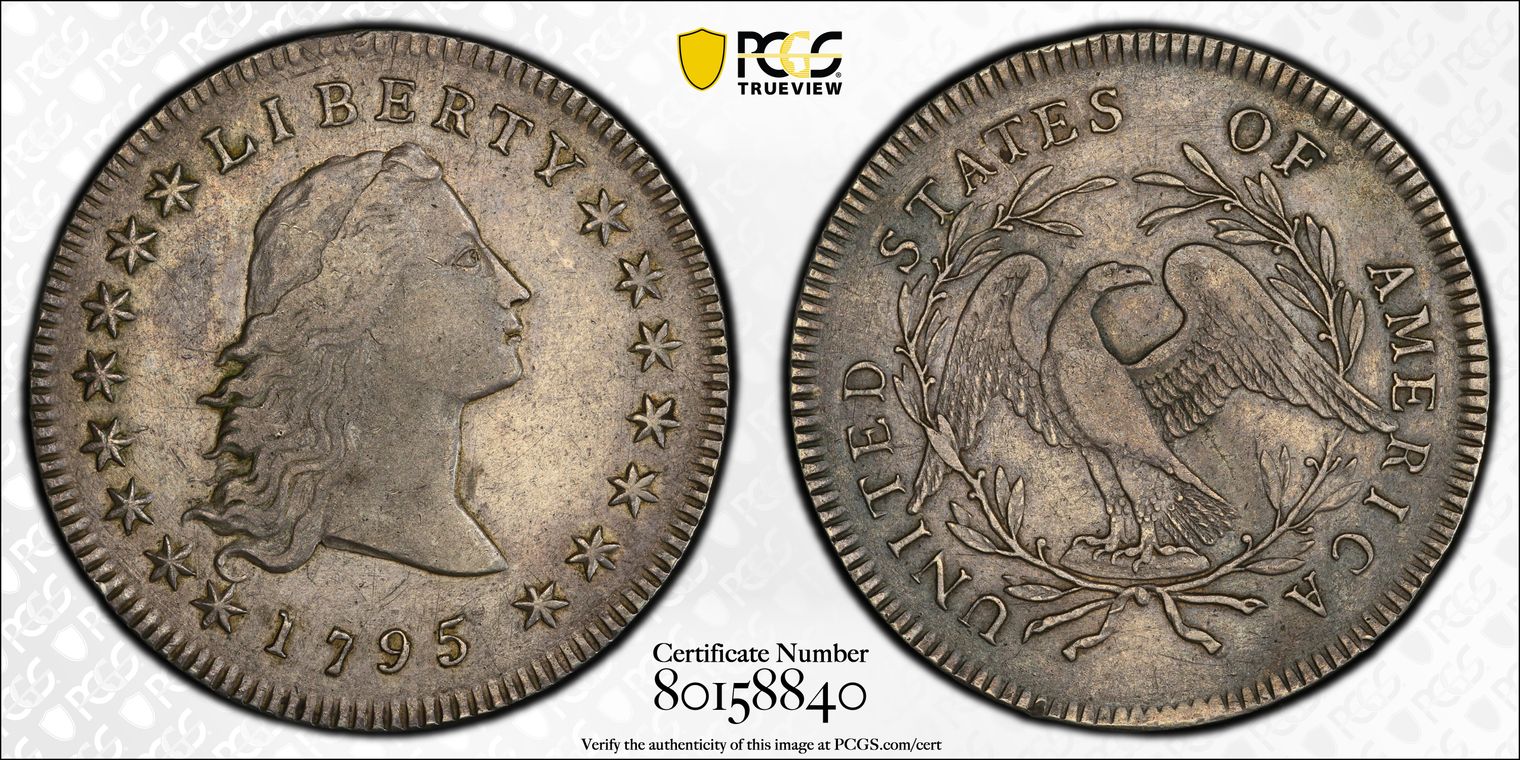1795 $1 Flowing Hair, BB-22 VF35 认证号80158840, PCGS号39987
专家评论
Q. David Bowers
The following narrative, with minor editing, is from my "Silver Dollars & Trade Dollars of the United States: A Complete Encyclopedia" (Wolfeboro, NH: Bowers and Merena Galleries, Inc., 1993). Note: the Notable Specimens list should be used with caution - it has been updated in my 2013 edition of "The Encyclopedia of United States Silver Dollars 1794-1804."Obv: Portrait II (Head of '95)
Rev: Eagle I, Wreath I (2 leaves)
(B-10. H-10.)
OBVERSE 6: Obverse die used to strike 1795 BB-21, BB-22, and BB-23.
REVERSE H: Two leaves below each wing. 18 berries arranged nine left and nine right. A berry is on the outside of the wreath opposite C in AMERICA, and only one berry opposite last A in AMERICA, that being on inside of wreath. Two berries on outside of wreath on right between eagle's wing and ribbon bow.
Note: Bolender said this about the reverse in his 1950 book: "10 [berries] on left branch and 9 on right. Capt. Haseltine was in error in calling this the '18-berry variety.' His specimen was a worn one, and even on Fine specimens the 19th berry shows very faintly on the inside of left stem near last single leaf."
Notwithstanding this seemingly definitive statement, I have been unable to find the nineteenth berry on any specimen examined, or on catalogue plates.
Reverse die used to strike 1795 BB-22 only.
DIE STATES:
Die State I: Perfect dies.
COLLECTING NOTES: 1795 BB-22 is a very rare variety of which probably no more than 25 to 50 are known. Virtually all are in lower grades through VF, a notable exception being the F.C.C. Boyd coin, later appearing on the market in other sales, which is a superb Uncirculated example. Bolender called this variety R-6 (13 to 30, if he was using the Sheldon Scale), which rating is essentially unchanged today.
In his 1881 Type-Table, J.W. Haseltine called this variety "excessively rare," which, presumably, means rare to excess, or rarer than it should be! A better word would have been exceedingly, but "excessively" seems to have insinuated itself into the American numismatic nomenclature, and over the years many cataloguers have used it (in fact, cataloguers on my staff have done so).
NOTABLE SPECIMENS:
Granberg Specimen. MS-60 or better, prooflike . H.O. Granberg Collection . World's Greatest Collection, F.C.C. Boyd, Numismatic Gallery, 1945: 12. Uncirculated. Bareford Collection, Stack's, 1981: 404. "Brilliant Uncirculated, wholly prooflike, even light gray-golden toning, exceptional strike." 400th Sale, Stack's, 1988: 1166, "Brilliant Uncirculated and wholly prooflike, even light gray toning; exceptional strike, even the ear is clear without magnification."
Brooks Specimen. VF-30 . Bowers and Merena, Brooks Collection, 1989: 160. "VF-30, surfaces have pearl gray toning with wisps of deeper iridescence around the letters, numerals, and stars; most design details exceptionally sharp for the grade."
Tecumseh Specimen. VF-25 . Steve Ivy, Tecumseh Sale, 1979: 793.
1952 ANA Sale Specimen. VF-20 . 1952 ANA Convention Sale, New Netherlands: 3099 Mid-American, September, 1985: 514 . H.W. Blevins Collection, Superior, 1988: 3592. "VF-20, exquisite example with superb original color, obverse and reverse deep rich gray which changes to gold in the protected areas, surfaces are virtually perfect with no adjustment marks or abrasions whatsoever; centering and strike are excellent."
PCGS #
39987
设计师
Robert Scot
边缘
Lettered: HUNDRED CENTS ONE DOLLAR OR UNIT
直径
40.00 毫米
重量
27.00 克
铸币数量
16029
金属成分
90% Silver, 10% Copper
更高评级数量
2
评级较低的钱币数量
3
地区
The United States of America
价格指南
PCGS 数量报告
拍卖 - PCGS 评级的
拍卖 - NGC 评级的
























